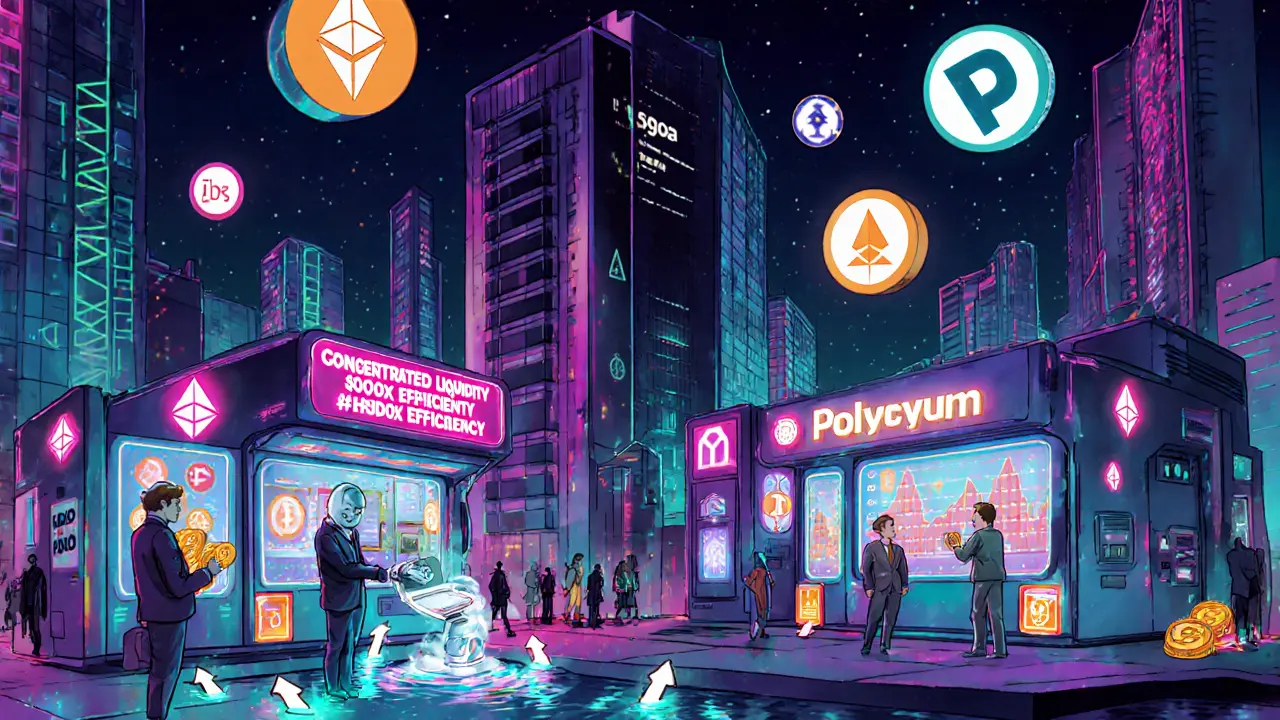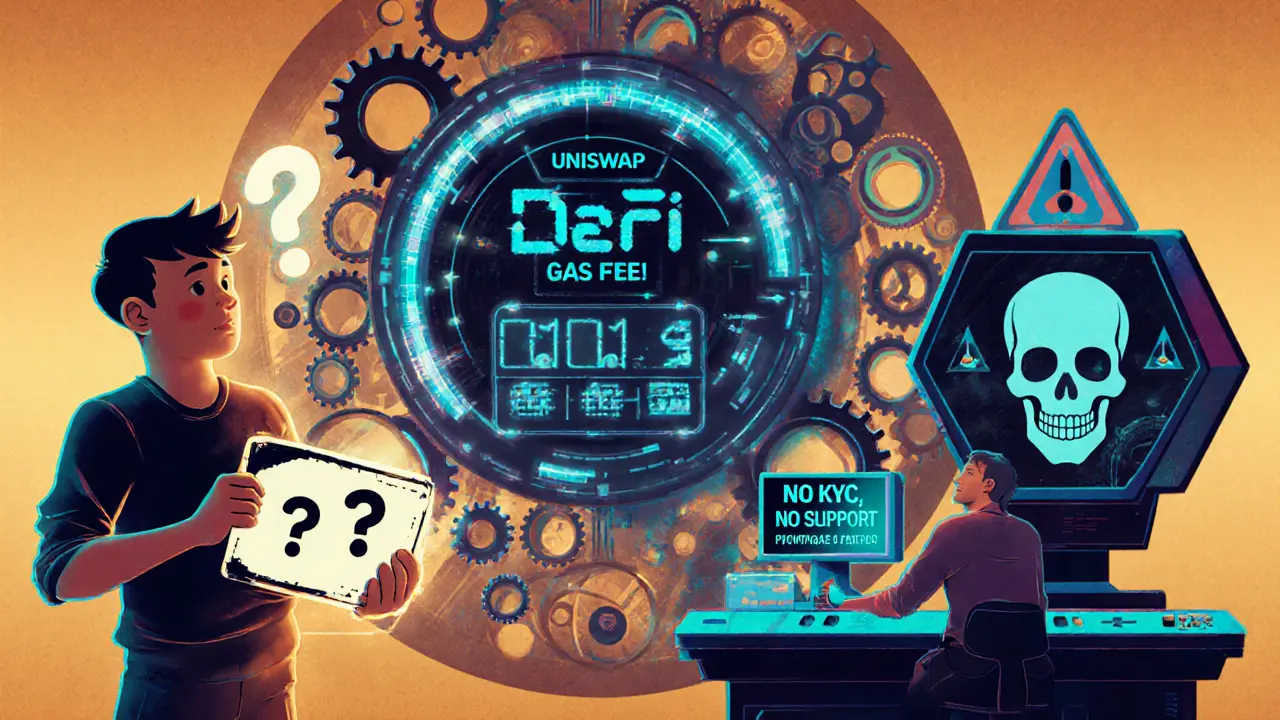Uniswap Crypto Exchange Review 2025: What You Need to Know Before Swapping Tokens
 Nov, 3 2025
Nov, 3 2025
Uniswap Gas Fee Calculator
Calculate your estimated swap costs across different blockchain networks. Based on current network conditions as of October 2025.
Select Your Options
Estimated Swap Costs
Network Recommendation
Important Notice
These are estimates only. Actual gas fees may vary significantly during network congestion. Always check current network conditions before swapping.
People keep typing USWAP when they mean Uniswap. It’s a common mistake, but it matters. Uniswap isn’t a traditional exchange you sign up for. It’s a decentralized protocol that runs on blockchain - no accounts, no KYC, no middleman. If you’re new to crypto and thinking of trading tokens, understanding what Uniswap really is could save you time, money, and headaches.
How Uniswap Works (No Order Books, No Brokers)
Unlike Coinbase or Binance, Uniswap doesn’t match buyers and sellers. Instead, it uses something called an Automated Market Maker (AMM). Think of it like a vending machine for crypto. You put in one token, you get another out. The price isn’t set by people bidding - it’s calculated by a math formula based on how much of each token is in a shared pool.
These pools are funded by everyday users like you. If you deposit $1,000 worth of ETH and USDC into a liquidity pool, you become a liquidity provider. In return, you earn a cut of every trade made in that pool - usually 0.3% per swap. That’s how Uniswap stays alive: community-powered liquidity, not corporate servers.
As of September 2025, Uniswap handles over $1.2 billion in daily trading volume across 11 blockchains. That’s more than all other decentralized exchanges combined. It’s the default choice for DeFi users because it just works - if you know how.
Uniswap V3: The Game-Changer in Liquidity
Uniswap V3, launched in May 2021, changed everything. Before V3, liquidity providers had to spread their funds across the entire price range of a token pair. That meant most of your money sat idle. V3 let you pick exactly where you want your funds to be active - say, between $3,000 and $3,500 for ETH/USDC.
This “concentrated liquidity” idea made capital 4,000x more efficient, according to Uniswap’s own docs. It’s why institutions now use Uniswap. Hedge funds and market makers can now deploy their capital precisely where trades are happening, not just everywhere.
It also introduced four fee tiers: 0.01% for stablecoin pairs (like USDC/DAI), 0.05% for semi-stable ones, 0.3% for most ETH/ERC-20 trades, and 1% for risky, low-volume tokens. The 0.3% fee is the default for most users. Compare that to Coinbase’s 0.6% fee for small traders - Uniswap is cheaper, if you can handle the complexity.
Which Chains Does Uniswap Run On?
Uniswap isn’t just on Ethereum anymore. It’s live on Polygon, Arbitrum, Optimism, Base, BNB Chain, Avalanche, Gnosis Chain, Fantom, Celo, zkSync, and more. This multi-chain approach is why it still dominates even as competitors rise.
Gas fees vary wildly depending on which chain you use:
- Ethereum mainnet: $1.50-$15 (can spike to $50+ during hype cycles)
- Polygon: $0.02-$0.05
- Arbitrum: $0.10-$0.50
- Base: $0.05-$0.20
If you’re swapping small amounts or trading new tokens, use Polygon or Base. You’ll pay less than a coffee. Ethereum is for big trades or when you need maximum liquidity - like swapping ETH for a new DeFi token with deep pools.
Wallets, Security, and What You Need to Get Started
You don’t need to sign up anywhere. Just connect a wallet. Uniswap works with MetaMask, Trust Wallet, Coinbase Wallet, Ledger Live, and others via WalletConnect. That’s it.
But here’s the catch: you’re responsible for everything. No password reset. No customer support. If you send tokens to the wrong address, they’re gone. If you set your slippage tolerance too high (say, 10% for a low-volume token), you could get ripped off by bots. Slippage is the difference between the price you see and the price you get - and it’s real.
Uniswap has been audited by OpenZeppelin and Trail of Bits. No major exploits since V2. But that doesn’t mean it’s safe for everyone. The security is in the code - not in human help. If your transaction fails, you won’t get a call from support. You’ll need to check Etherscan, adjust your settings, and try again.

Who Is Uniswap For? (And Who Should Avoid It)
Uniswap is perfect if you:
- Own crypto and want to swap between tokens without KYC
- Understand gas fees and slippage
- Want access to thousands of tokens no CEX lists
- Are comfortable with self-custody
But avoid it if you:
- Need to buy crypto with a credit card or bank transfer (Uniswap doesn’t support fiat)
- Get nervous when transactions fail
- Don’t know what a wallet address is
- Expect customer service when something goes wrong
A 2025 survey of 1,200 users found 78% of experienced DeFi traders were happy with Uniswap. But only 42% of beginners felt the same. The top complaints? High Ethereum gas fees and no fiat on-ramps. The top praises? No KYC and massive token selection.
How It Compares to Other DEXs
Uniswap leads in volume and liquidity, but it’s not the only option.
| Feature | Uniswap | PancakeSwap | SushiSwap | Aster |
|---|---|---|---|---|
| Chains Supported | 11 | 4 | 7 | 5 |
| Standard Swap Fee | 0.3% | 0.25% | 0.2% | 0.035% (taker) |
| Fiat On-Ramp | No | No | No | No |
| Advanced Features | Concentrated liquidity | Yield farming | Staking, voting | Hidden orders, MEV protection |
| Best For | Deep liquidity, ETH/ERC-20 swaps | Binance Chain users | Multi-chain rewards | Low fees, professional traders |
Aster and other newer DEXs are eating into Uniswap’s market share. They offer better MEV protection, lower fees, and smarter routing. But Uniswap still has the deepest pools. For ETH/USDC, slippage on a $10,000 trade is just 0.05%. On most other DEXs, it’s over 0.5%.
Regulation and the Future: What’s Next?
In March 2025, Uniswap Labs settled with the SEC over how UNI tokens were distributed. But the protocol itself? Still non-custodial. Still unregulated. That’s intentional. The team built it to be unstoppable - no central point to shut down.
Uniswap V4 is coming in Q1 2026. It’ll let developers build custom pool behaviors using “hook contracts.” Imagine pools that auto-rebalance, charge dynamic fees, or even integrate with lending protocols - all on-chain. This could make Uniswap the foundation for the next wave of DeFi innovation.
Market share has dropped from 68% in January 2025 to 58.7% now. But liquidity is still king. Consensys Analytics gives Uniswap a 72% chance of staying #1 through 2027. Why? Because no one else has its depth, its network effect, or its developer base.

Real User Experiences
On Reddit, one user wrote: “Swapped 5 ETH for SHIB on Polygon through Uniswap. Paid $0.03 gas and 0.3% fee. Total cost: $1.87. Cheaper and faster than any CEX.” That’s the sweet spot.
But on Trustpilot, 58% of negative reviews say: “No support when my transaction failed.” And 32% complain about Ethereum gas spikes. That’s the reality. Uniswap doesn’t fix your mistakes. It just executes your trades.
Beginners take about 22 minutes to complete their first swap. Most fail on the first try - usually because they set slippage too high or picked the wrong network. It’s not hard. But it’s not beginner-friendly either.
Final Verdict: Is Uniswap Right for You?
Uniswap is the most powerful decentralized exchange in the world. It’s open, transparent, and unstoppable. If you’re serious about crypto and want access to every token ever created, it’s your best tool.
But it’s not a bank. It’s not a trading app. It’s a protocol. You’re the operator. You need to understand gas, slippage, wallet security, and chain selection. If you don’t, you’ll lose money - not because it’s broken, but because you didn’t learn how to use it.
Start small. Use Polygon or Base. Swap $10 worth of ETH for a token you’ve researched. Watch the transaction go through. Learn what slippage means. Then try again. Once you get it, you’ll never go back to centralized exchanges for token swaps.
Uniswap doesn’t need to be perfect. It just needs to work. And after six years, it still does - better than anyone else.
Is USWAP the same as Uniswap?
No. USWAP is a misspelling. The correct name is Uniswap. There is no crypto exchange called USWAP. If you see a website or app using that name, it’s likely a scam. Always double-check the official site: uniswap.org.
Do I need to verify my identity to use Uniswap?
No. Uniswap is non-custodial and requires no KYC. You connect your wallet and start trading. This is one of its biggest advantages over centralized exchanges like Coinbase or Binance. But it also means there’s no recovery option if you lose your private key or send funds to the wrong address.
Why are Ethereum gas fees so high on Uniswap?
Ethereum gas fees depend on network congestion, not Uniswap itself. During high demand - like when a new token launches - fees can spike to $50 or more. To avoid this, switch to Layer 2 chains like Polygon, Arbitrum, or Base, where fees are under $0.10. Uniswap works on all of them.
Can I buy crypto with USD on Uniswap?
No. Uniswap only accepts crypto. You can’t deposit dollars or euros. You need to buy ETH or USDC first on a centralized exchange like Coinbase or Kraken, then transfer it to your wallet before using Uniswap.
Is Uniswap safe from hacks?
The Uniswap protocol has never been hacked since V2 launched in 2020. It’s been audited by top security firms like OpenZeppelin and Trail of Bits. But your wallet isn’t safe if you click a phishing link or share your private key. Uniswap is secure - your actions determine your risk.
What’s the difference between Uniswap V3 and V4?
V3 introduced concentrated liquidity, letting providers earn more fees by targeting specific price ranges. V4, launching in early 2026, adds customizable “hook contracts” that let developers build new types of pools - like auto-compounding, fee-shifting, or cross-chain pools. V4 will make Uniswap even more flexible for institutional use.
Should I provide liquidity on Uniswap?
Only if you understand impermanent loss - the risk of losing value when token prices change. Providing liquidity can earn you fees, but you could end up with less value than if you just held the tokens. Start with stablecoin pairs (like USDC/DAI) where price swings are small. Avoid high-volatility tokens until you’ve learned the risks.
Next Steps: How to Start Using Uniswap
- Download a wallet like MetaMask or Trust Wallet.
- Buy ETH or USDC on a centralized exchange (like Coinbase or Kraken).
- Transfer that crypto to your wallet.
- Go to app.uniswap.org and connect your wallet.
- Choose a chain (start with Polygon or Base if you’re new).
- Enter the token you want to swap, set slippage to 0.5%-1%, and confirm.
- Track your transaction on Etherscan or the chain’s block explorer.
Do this once with $10. See how it works. Then try again. Uniswap won’t hold your hand - but once you figure it out, you’ll never need one again.